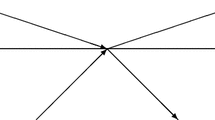Abstract
We consider the possibility that the relative phase in quantum mechanics plays a role in determining measurement outcome and could therefore serve as a “hidden” variable. The Born rule for measurement equates the probability for a given outcome with the absolute square of the coefficient of the basis state, which by design removes the relative phase from the formulation. The value of this phase at the moment of measurement naturally averages out in an ensemble, which would prevent any dependence from being observed, and we show that conventional frequency-spectroscopy measurements on discrete quantum systems cannot be imposed at a specific phase due to a straightforward uncertainty relation. We lay out general conditions for imposing measurements at a specific value of the relative phase so that the possibility of its role as a hidden variable can be tested, and we discuss implementation for the specific case of an atomic two-state system with laser-induced fluorescence for measurement.



Similar content being viewed by others
Notes
We implicitly mean a specific value of ϕ mod2π.
See, for example, [13], for a discussion of state reduction via null measurement.
More precisely, this could be called the minimum measurement time or the quantum measurement time. In the presence of technical noise, more averaging may be required to determine the state of the system.
References
Wheeler, J.A., Zurek, W.H. (eds.): Quantum Theory and Measurement. Princeton University Press, Princeton (1983)
Adler, S.L.: Probability in orthodox quantum mechanics: probability as a postulate versus probability as an emergent phenomenon (2000). quant-ph/0004077
Smolin, L.: The Trouble with Physics, pp. 3–11. Houghton Mifflin Company, Boston (2007)
Everett, H. III: “Relative state” formulation of quantum mechanics. Rev. Mod. Phys. 29, 454–462 (1957)
Griffiths, R.B.: Consistent Quantum Theory. Cambridge University Press, Cambridge (2002)
Ghirardi, G.C., Pearle, P., Rimini, A.: Markov processes in Hilbert space and continuous spontaneous localization of systems of identical particles. Phys. Rev. A 42, 78–89 (1990)
Adler, S.L., Bassi, A.: Is quantum theory exact? Science 325, 275–276 (2009)
Bohm, D.: A suggested interpretation of the quantum theory in terms of “hidden” variables. Phys. Rev. 85, 166–179 (1952)
Bell, J.S.: On the Einstein-Podolsky-Rosen paradox. Physics 1, 195–200 (1964)
Godun, R.M., D’Arcy, M.B., Summy, G.S., Burnett, K.: Prospects for atom interferometry. Contemp. Phys. 42, 77–95 (2001)
Herzberg, G.: Atomic Spectra and Atomic Structure, pp. 82–119. Dover, New York (1944)
Cohen-Tannoudji, C., Dupont-Roc, J., Grynberg, G.: Atom-Photon Interactions, pp. 259–266. Wiley, New York (1992)
Porrati, M., Putterman, S.: Wave-function collapse due to null measurements: the origin of intermittent atomic fluorescence. Phys. Rev. A 36, 929–932 (1987)
Mueller, H., Chiow, S., Herrmann, S., Chu, S.: Nanosecond electro-optical switching with a repetition rate above 20 MHz. Rev. Sci. Instrum. 78, 124702 (2007)
Author information
Authors and Affiliations
Corresponding author
Rights and permissions
About this article
Cite this article
Peil, S. Proposed Test of Relative Phase as Hidden Variable in Quantum Mechanics. Found Phys 42, 1523–1533 (2012). https://doi.org/10.1007/s10701-012-9680-6
Received:
Accepted:
Published:
Issue Date:
DOI: https://doi.org/10.1007/s10701-012-9680-6




